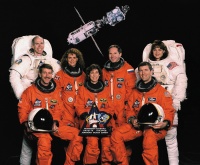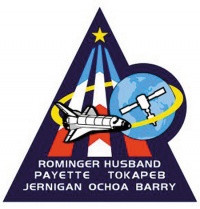STS-96
From The Space Library
 | |
| Organization | NASA-Office of Space Flight (United States) |
|---|---|
| Mission type | Human Crew |
| Launch date | May 27, 1999 |
| Launch vehicle | Space Shuttle |
| Launch site | Cape Canaveral, United States |
| COSPAR ID | 1999-030A |
| Inclination | 51.6 degrees |
| Experiments | Here |
| Alternate Names | 25760 |
| Additional Information | Here |
| Telecommunications Information | Here |
| Data Collection | Here |
| Payload Mass Up | 10299.72 kg |
| Payload Mass Down | 8813.64 kg |
| Orbiter | Discovery |
| Lift Off Mass | 2,051,923.18 kg |
| Orbiter Weight at Liftoff | 103,624.55 kg |
| Orbiter Weight at Landing | 100,756.36 kg |
| Landed | Concrete runway 15 at Kennedy Space Center, Fla. |
| Orbits of Earth | 154 |
| Orbital Altitude | 173 nautical miles (199 statute miles) |
Contents |
[edit] Crew
- Commander: Kent V. Rominger
- Pilot: Rick D. Husband
- Payload Commander:
- Mission Specialist 1: Ellen Ochoa
- Mission Specialist 2: Tamara E. Jernigan
- Mission Specialist 3: Daniel T. Barry
- Mission Specialist 4: Julie Payette, Canadian Space Agency
- Mission Specialist 5: Valery Ivanovich Tokarev, Russian Space Agency
- Payload Specialist 1:
- Payload Specialist 2:
ISS/Mir Crew Transport
[edit] Mission
STS 96 was an American shuttle spacecraft. Its primary mission was to ferry two tons of supplies and spare parts to the International Space Station. The crew carried out some repair and maintainance work on ISS and installed mufflers to reduce the noisy fans in the Zarya module. The crew also installed a Russian crane called Strela on Zarya. The shuttle also boosted ISS to a higher altitude and released a small free-flying sphere named STARSHINE to encourage students to track it visually. Other payloads on STS-96 were the Student Tracked Atmospheric Research Satellite for Heuristic International Networking Equipment (STARSHINE), the Shuttle Vibration Forces Experiment (SVF) and the Orbiter Integrated Vehicle Health Monitoring - HEDS Technology Demonstration (IVHM HTD). The STARSHINE satellite consisted of an inert, 19-inch hollow sphere covered by 1,000 evenly-distributed, flat, polished mirrors, each 1 inch in diameter. The payload consisted of the STARSHINE satellite, integrated with the Pallet Ejection System (PES), then mounted inside a lidless carrier. The HH equipment consisted of one HH Lightweight Avionics Plate (LAP), then mounted inside a lidless carrier. Additional HH equipment consists of one Hitchhiker Ejection System Electronics (HESE), one 5.0 cubic-foot HH canister, and one Adapter Beam Assembly (ABA). The purpose of the mission was to train international student volunteer observers to visually track this optically reflective spacecraft during morning and evening twilight intervals for several months, calculate its orbit from shared observations, and derive atmospheric density from drag-induced changes in its orbit over time. The Shuttle Vibration Forces (SVF) Experiment provided flight measurements of the vibratory forces acting between an aerospace payload and its mounting structure. The force transducers were incorporated into four custom brackets which will replace the existing brackets used to attach the 5 ft standard canister to the side wall GAS adapter beam. The payload was activated automatically by the Orbiter Lift-off vibration and will operate for approximately 100 seconds. STS-96 was the second flight of the SVF experiment The purpose of the Orbiter Integrated Vehicle Health Monitoring- HEDS Technology Demonstration (IVHM HTD) was to demonstrate competing modern, off-the-shelf sensing technologies in an operational environment to make informed design decisions for the eventual Orbiter upgrade IVHM. The objective of IVHM was to reduce planned ground processing, streamline problem troubleshooting (unplanned ground processing), enhance visibility into systems operation and improve overall vehicle safety.
[edit] EVA
Extravehicular Activity (EVA) conducted by Tamara Jernigan and Daniel Barry, 7 hours, 55 minutes. During the EVA, Jernigan and Barry transferred and installed two cranes from the shuttle's payload bay to locations on the outside of the station. They also installed two new portable foot restraints that will fit both American and Russian space boots and attached three bags filled with tools and handrails that will be used during future assembly operations. Once those primary tasks were accomplished, Jernigan and Barry installed an insulating cover on a trunnion pin on the Unity module, documented painted surfaces on both the Unity and Zarya modules, and inspected one of two early communications system antennas on the Unity. Other tasks completed during the space-walk included moving foot restraints into PMA-1 (pressurized mating adapter) and installing three bags containing tools for use during later flights. Throughout the spacewalk, Jernigan and Barry were assisted by their crew mates as Mission Specialist Ellen Ochoa operated the shuttle's robot arm to maneuver Jernigan around Discovery's cargo bay, and Canadian Space Agency astronaut Julie Payette acted as "choreographer" of the spacewalk from Discovery's flight deck.
[edit] Payload
International Space Station (A.1); SPACEHAB double module; Integrated Vehicle Health Monitoring HEDS Technology Demonstration 2; Student-Tracked Atmospheric Research Satellite for Heuristic International Networking Equipment (STARSHINE); Shuttle Vibration Forces Experiment; MIRTS change-out; cargo transfer
[edit] Books about the Space Shuttle Program
Buy This Book Click here |
Buy This Book here |
Buy This Book Click here |
Buy This Book Click here |





